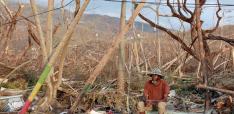Science Diplomacy to Reinforce the Biological Weapons Convention: A Strategic Agenda for Global Biosecurity

Jasmina Saric, Cedric Invernizzi, Filippa Lentzos, Mary Onsarigo and Luk Van Langenhove call for a coordinated science diplomacy strategy to bridge science and security, strengthen the BWC and advance international trust in biosecurity governance.
Momentum around the Biological and Toxin Weapons Convention (BWC) is building. In August, the Working Group to strengthen the treaty concluded its sixth session in Geneva with progress on a draft final report; a month later, US President Donald Trump’s UN address pledged US leadership on BWC enforcement. Yet, after 50 years since entry into force, the treaty continues to face persistent and structural challenges. It lacks a verification regime to monitor and assess compliance, and it grapples with rapidly evolving scientific and geopolitical pressures. The exponential pace of developments in the life sciences, combined with the convergence of science disciplines and the globalisation of research has created new layers of complexity. Rapid innovation coupled with limited regulatory oversight is lowering barriers to repurposing life sciences for harm. This challenge is amplified by the fact that a large share of countries lack national-level oversight for dual-use research. At the same time, the global expansion of high-containment laboratories raises concerns over uneven biosafety standards and variable safety cultures. These scientific and biosafety trends are unfolding amid intensifying geostrategic rivalries among major powers that further constrain the multilateral response.
The BWC sits at the interface of defence diplomacy and science diplomacy, being first and foremost a security treaty, rooted in arms control that simultaneously relies on scientific collaboration and expertise to not only regulate dual-use biotechnology, but to build trust and prevent misuse. Focusing on this intersection, we examine the most relevant science diplomacy approaches that can practically strengthen the Convention. Drawing on recent literature and our own professional experience, we argue that a targeted, coordinated and integrated approach across four science diplomacy priority areas offers a realistic path forward to strengthen biosecurity governance.
Embedding Responsibility in the Life Sciences
During the Cold War, a five-fold system of research security controls was introduced: information classification, export controls, conditions for public funding, voluntary restrictions on the private sector and controls on visitors and visas. UK Research and Innovation recently proposed the inclusion of ‘security by intentionality’ to this framework, where researchers must not only comply with controls but also reflect on the motivations of international counterparts: are they seeking funding, new knowledge or geopolitical leverage? Scientists are now asked to oversee their research as well as to safeguard modern bioscience tools, shifting from passive compliance to active responsibility.
The European Framework for Science Diplomacy (2025) reinforces this shift by adding a fourth science diplomacy domain – ‘diplomacy in science’ – to the traditional three. This domain recognizes that scientists themselves increasingly need diplomatic skills to navigate international collaboration responsibly. A similar logic underpins the 2024 Report on the Future of the EU Single Market, which proposes a new “fifth freedom” dedicated to the free movement of research, innovation, knowledge and education. By institutionalizing the cross-border circulation of knowledge, this fifth freedom also highlights researcher’s responsibility to navigate governance, ethics and security issues. The EU’s evolution from “open innovation, open science, open to the world” (2015) to “as open as possible and as closed as necessary” (2020) further reflects how academia must protect core scientific values while ensuring compliance with export controls and knowledge-security measures.
Engaging the next generation of scientists through outreach and education becomes essential; empowering them to ‘think security’, foster a culture of responsibility and ensure science and innovation serve peaceful ends. An internationally agreed-upon code of conduct for life sciences – long debated – should provide the overarching framework for this effort.
Institutionalising Scientific Advice for the BWC
As for a more standardized code of conduct, there have been numerous calls over the years to create a Scientific Advisory Mechanism for the BWC. Similar to the Intergovernmental Panel on Climate Change, such a mechanism could provide policymakers with timely, evidence-based scientific insights – science in diplomacy – ensuring the BWC remains agile and effective in the face of rapidly evolving biosciences. In its current form, the draft final report of the Working Group to strengthen the BWC includes a recommendation to establish a mechanism “to review and assess scientific and technological developments relevant to the Convention and to provide States Parties with relevant advice.” Such a mechanism could also serve to strengthen awareness of the security dimensions of the life sciences and to reinforce accountability and research integrity.
Relevant initiatives and support mechanisms already exist. The UN Secretary-General's Mechanism (UNSGM) for investigating alleged uses of biological and chemical weapons relies on a roster of life scientists and labs for investigative or verification roles. Similarly, the biennial Spiez Convergence conference brings together international experts in science and security to review emerging trends in the life sciences and assess their potential implications for the BWC. Both provide important entry points for connecting scientific expertise with security policy and could be leveraged to operationalise the proposed advisory mechanism.
Regional Leadership as a Catalyst for Biosecurity Capacity
International biosecurity capacity-building is critical – practical training for biocontainment laboratory personnel reduces the risk of accidents and future pandemics while fostering transparency and trust between partner facilities. In recent years, biosecurity capacity-building has followed two trajectories. Some resource-rich actors, notably the US, have scaled back engagement in low- and middle-income countries. At the same time, actors in non-Western countries have increasingly been taking ownership, investing resources and networks into biosafety and biosecurity.
Professional associations in Southeast Asia, for instance, have begun designing risk assessment frameworks and laboratory standards, filling gaps left by retreating international actors. In East/Southern Africa, we have first-hand experience of how capacity can spread through science diplomacy. In 2024, we co-organized a bilateral Kenya–Switzerland science diplomacy workshop, where Kenya’s biosecurity priorities were explicitly identified as part of its national science diplomacy agenda. With technical support from South Africa and Switzerland, Kenya for the first time engaged scientists, researchers and laboratory managers from 37 institutions in preparing its Confidence-Building Measures (CBM) submission under the BWC. Spiez Laboratory from Switzerland provided technical expertise, while the BWC-Implementation Support Unit facilitated a national workshop.
A network of BWC champions was established to coordinate CBM reporting, which has since expanded to include more stakeholders with a deeper understanding of the Convention. This momentum has extended regionally. Inspired by the leadership and best practices of Kenya and South Africa, Botswana submitted its first CBM in 2022 and is now mentoring neighbouring countries in reporting and implementation efforts.
Capacity-building, however, cannot be limited to scientists. Diplomats and decision-makers also need specialized knowledge of biosciences and dual-use threats, which increasingly outpace existing regulatory frameworks. Embedding science attachés, developing targeted training programmes and the integrating technical expertise into foreign ministries and multilateral delegations are essential to bridge the gap between science and diplomacy.
Together, these capacity-building efforts – science for diplomacy in action – demonstrate that regional ownership, peer-to-peer mentorship and sustained partnerships are critical to advancing biosecurity. International assistance remains important, but the most durable progress comes from empowering local leadership through institutions, scientific networks and diplomatic actors. In this regard, the implementation of Article X of the BWC, on promoting international cooperation and assistance, offers a valuable platform for science diplomacy, where transparent exchanges of knowledge, equipment and technology foster both cooperation and trust.
Strategic Science Communication as a Pillar of Science Diplomacy
At the Kenya–Switzerland Science Diplomacy workshop, participants emphasized the need to formally recognize science communication as a key element of science diplomacy. A cross-cutting domain – Strategic Science Communication in Science Diplomacy – was proposed to address growing regional and global demands, with dual-use identified as a priority area. The dual-use paradox highlights the challenge of communicating both the benefits of scientific progress and its potential for misuse, while protecting researchers at the science–security interface.
The concerns are compounded by geopolitical disinformation campaigns. Global Partnership-funded biosecurity capacity-building initiatives worldwide have been targeted by narratives alleging that public and animal health laboratories are engaging in ‘military biological activities’ in contravention of the BWC. The false allegations, part of Russia’s disinformation campaigns during its war on Ukraine, not only weaken international cooperation, jeopardize capacity-building and endanger scientists, but also significantly undermine the international architecture against biological weapons.
Experts have long warned about the rise of anti-science across regions, highlighting three urgent needs: combating disinformation, improving science communication and defending science as part of an integrated strategy. Science communication in science diplomacy is therefore not simply about outreach; it must be a strategic instrument for building trust, countering disinformation and safeguarding scientific integrity.
Managing the Biosecurity Paradox: Trust through Science Diplomacy
We are entering a period where science diplomacy will be tested against its very purpose. The paradox is clear: trust is both the most fragile element in international cooperation and the strongest foundation of global biosecurity.
The four priority areas for strengthening biosecurity governance through science diplomacy – responsible life sciences, a scientific advisory mechanism, capacity-building and strategic science communication – position science diplomacy not merely as a support instrument but as a strategic enabler for reinforcing the BWC and global biosecurity governance. Advancing these areas in a focused, coordinated and integrated manner offers a balanced and credible response to this paradox. Managing it wisely will place science diplomacy at the forefront of efforts to safeguard against biological threats.
Jasmina Saric is a Senior Scientific Collaborator at the Swiss Tropical and Public Health Institute (Swiss TPH) with a decade of research experience focused on Swiss bilateral research cooperation and partnerships and science diplomacy. Her recent publications and policy briefs highlighting the emerging priority of biosecurity in Swiss and Swiss–African science diplomacy contexts.
Filippa Lentzos is Associate Professor in Science & International Security in the Department of War Studies at King’s College London. She is also an Associate Senior Researcher at the Stockholm International Peace Research Institute (SIPRI). She brings extensive international expertise in biosecurity and dual-use governance as Chair of the WHO Technical Advisory Group on the Responsible Use of the Life Sciences and Dual-Use Research, and as a member of the WHO Health Security Interface – Technical Advisory Group.
Cédric Invernizzi is Head of the Nuclear, Biological and Chemical (NBC) Arms Control Division at Spiez Laboratory, Switzerland and brings over a decade of expertise in biological arms control. He leads international initiatives, such as the Spiez Convergence conference and the UNSGM laboratory network and provides technical expertise to support BWC confidence-building and global laboratory capacity-building efforts. Cédric contributed to this article in his personal capacity. The views expressed in this article are those of the author only and do not necessarily represent the position or opinion of Spiez Laboratory or the Swiss Government.
Mary Onsarigo is a Principal Science Analyst at the National Commission for Science, Technology & Innovation (NACOSTI) Kenya. She brings expertise in biosecurity governance and Confidence-Building Measures, and she plays a central role in Kenya’s CBM submission process and its continuous improvement, fostering cross-sectoral engagement and sharing best practices with other African countries.
Luk Van Langenhove is Professor Emeritus at the Brussels School of Governance of the Vrije Univeristeit Brussel. He brings longstanding expertise in international affairs and science diplomacy, drawing on leadership roles at the United Nations University and the Belgian Federal Ministry of Science Policy. He was a key advocate for integrating “diplomacy in science” into the European Framework for Science Diplomacy and contributed directly to its development.
Photo by Ivan Samkov


